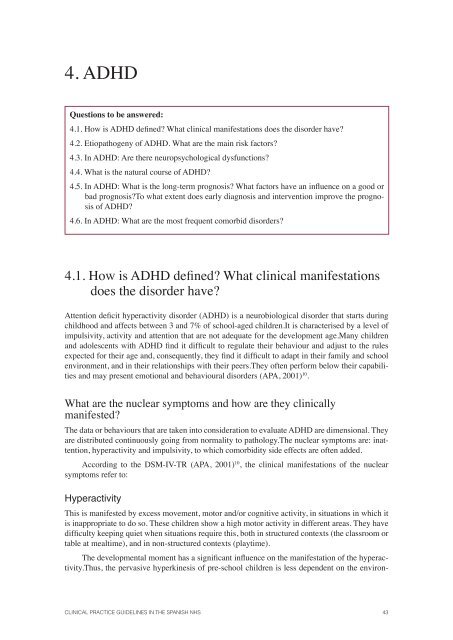CPG on ADHD
CPG on ADHD
CPG on ADHD
- No tags were found...
You also want an ePaper? Increase the reach of your titles
YUMPU automatically turns print PDFs into web optimized ePapers that Google loves.
4. <strong>ADHD</strong>Questi<strong>on</strong>s to be answered:4.1. How is <strong>ADHD</strong> defined? What clinical manifestati<strong>on</strong>s does the disorder have?4.2. Etiopathogeny of <strong>ADHD</strong>. What are the main risk factors?4.3. In <strong>ADHD</strong>: Are there neuropsychological dysfuncti<strong>on</strong>s?4.4. What is the natural course of <strong>ADHD</strong>?4.5. In <strong>ADHD</strong>: What is the l<strong>on</strong>g-term prognosis? What factors have an influence <strong>on</strong> a good orbad prognosis?To what extent does early diagnosis and interventi<strong>on</strong> improve the prognosisof <strong>ADHD</strong>?4.6. In <strong>ADHD</strong>: What are the most frequent comorbid disorders?4.1. How is <strong>ADHD</strong> defined? What clinical manifestati<strong>on</strong>sdoes the disorder have?Attenti<strong>on</strong> deficit hyperactivity disorder (<strong>ADHD</strong>) is a neurobiological disorder that starts duringchildhood and affects between 3 and 7% of school-aged children.It is characterised by a level ofimpulsivity, activity and attenti<strong>on</strong> that are not adequate for the development age.Many childrenand adolescents with <strong>ADHD</strong> find it difficult to regulate their behaviour and adjust to the rulesexpected for their age and, c<strong>on</strong>sequently, they find it difficult to adapt in their family and schoolenvir<strong>on</strong>ment, and in their relati<strong>on</strong>ships with their peers.They often perform below their capabilitiesand may present emoti<strong>on</strong>al and behavioural disorders (APA, 2001) 10 .What are the nuclear symptoms and how are they clinicallymanifested?The data or behaviours that are taken into c<strong>on</strong>siderati<strong>on</strong> to evaluate <strong>ADHD</strong> are dimensi<strong>on</strong>al. Theyare distributed c<strong>on</strong>tinuously going from normality to pathology.The nuclear symptoms are: inattenti<strong>on</strong>,hyperactivity and impulsivity, to which comorbidity side effects are often added.According to the DSM-IV-TR (APA, 2001) 10 , the clinical manifestati<strong>on</strong>s of the nuclearsymptoms refer to:HyperactivityThis is manifested by excess movement, motor and/or cognitive activity, in situati<strong>on</strong>s in which itis inappropriate to do so. These children show a high motor activity in different areas. They havedifficulty keeping quiet when situati<strong>on</strong>s require this, both in structured c<strong>on</strong>texts (the classroom ortable at mealtime), and in n<strong>on</strong>-structured c<strong>on</strong>texts (playtime).The developmental moment has a significant influence <strong>on</strong> the manifestati<strong>on</strong> of the hyperactivity.Thus,the pervasive hyperkinesis of pre-school children is less dependent <strong>on</strong> the envir<strong>on</strong>-CLINICAL PRACTICE GUIDELINES IN THE SPANISH NHS 43

















